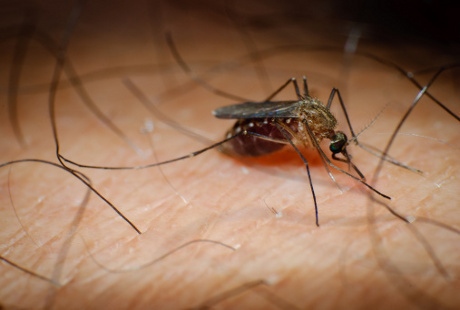At this time of the year as we transition from the dry season to the wet season dengue fever is prevalent in Jakarta. It is important to understand the illness and what preventive measures can be taken against dengue fever. Thank you to International SOS, Jakarta, for the following information.
Q: Is dengue fever a dangerous illness?
A.: Dengue fever is a relatively common problem in Jakarta and periodically reaches epidemic proportions, usually every 4-5 years. It is very rarely fatal in healthy and fit individuals, although the patient is often left debilitated and requires considerable convalescence.
Q: How is dengue fever transmitted?
A: Dengue occurs due to infection by a FLAVIVIRUS, which is transmitted by the bite of the Aedes mosquito.
Q: What are the symptoms of dengue fever?
A: Following an incubation period of 2 – 14 (usually 4 – 8) days, onset of symptoms is usually abrupt with chills, headache, backache, weakness, pain behind the eyes, and lassitude. (The joint and back pains can be very bad indeed; hence the older name breakbone fever). The temperature rapidly rises, often to 40°C (104°F), and there is a low heart rate. The blood pressure is often also low. After 2 – 4 days, a temporary improvement can occur with a sudden drop in temperature and subjective improvement – for 24 hours until there is a second rapid temperature rise, and the appearance of a characteristic rash on the trunk, limbs, palms and soles especially. The skin in these areas turns bright red and may peel. (This second febrile phase does not invariably occur). Thereafter there is slow improvement. Convalescence can take weeks, and bed rest and antipyretics and analgesics are required.
Q: Is there a test to confirm the diagnosis?
A: There are no immediate useful tests for dengue fever. The white blood cell count is often low unlike in bacterial causes of fever. The dengue antibody test can give both false positive and false negative results, especially in the first week of the disease. The diagnosis will in a large proportion of cases be based on clinical presentation and a characteristic drop of platelets in the blood.
Q: If you have had dengue fever can you get it again?
A: An attack produces immunity for a year or more, but only to the one of the four FLAVIVIRUS strains responsible.
Q: What is dengue haemorrhagic fever?
A: A rare complication of dengue fever, dengue haemorrhagic fever, can occur, most often in small children and elderly adults. This can sometimes be a serious illness. If DHF occurs it will usually do so by day 3-5 of the fever. It has been suggested that DHF is more likely if the patient has previously had an attack of dengue within the last calendar year, and that the occurrence of DHF relates to this previous “sensitizationâ€. The relationship between DHF and previous dengue infection is not this clear-cut, but previous exposure does raise the incidence of subsequent DHF. Uncontrolled bleeding distinguishes this from uncomplicated dengue fever. Bleeding can occur from the gums, nose, intestine, or under the skin as bruises or spots of blood especially under a tourniquet – this test should be employed if there is any suspicion. The liver is often enlarged.
Q: How should DHF be treated?
A: Patients can have rapid onset of marked drowsiness, lethargy or restlessness or the presence of shock as manifested by a rapid and weak pulse, low blood pressure and cold clammy skin. Such patients should be immediately referred to a good hospital for further management. DHF shock can be a mortal illness and requires rapid and careful in-hospital management with assiduous correction and replacement of fluid, electrolytes, plasma and sometimes fresh blood / platelet transfusions. The most useful laboratory test in suspected DHF is estimation of thrombocytes (platelets), which will be very low. In contrast to uncomplicated dengue fever the white cell count is more often high. Mortality from DHF ranges from 5 – 30% (in untreated native populations) and the highest risk is to infants under 1 year.
Q: What preventive measures should be taken against mosquitoes?
A: All varieties of mosquitoes breed in or near water that is stagnant or slow moving. The importance of mosquitoes in transmission of disease makes adequate control of mosquito-breeding sites very important, especially those close to human habitation. Personal protective measures can greatly reduce the risk of being bitten.
1. The use of mosquito deterrents in bedrooms is effective to reduce the number of mosquitoes in the room, but it does not prevent mosquito bites all together. The chemical deterrent is released through an electronically heated impregnated pad or gel, and its effectiveness depends largely on the size and ventilation of the room.
2. Correct use of mosquito nets (essential if accommodation is not air- conditioned). For added protection for up to 3 months or longer, mosquito nets can be soaked in 1 % solution of PERMETHRIN (or other repellent / insecticide). If resident in a malaria area,curtains can be treated in a similar manner.
3. Use of mosquito coils and knockdown spray (containing pyrethoids) – spray insecticide in cool dark places where mosquitoes lurk.
4. Avoid use of dark colored clothing, perfumes and colognes in the evening and at night, as all these attract mosquitoes.
5. Use of an effective mosquito repellent on exposed skin and clothing. DEET (diethylmethylbenzamide) is an effective safe component of good repellents. The actual concentration of DEET varies widely between different manufacturers, and can be as high as 90% (too high for safety). Choose a repellent with between 30-45% DEET and take the following precautions against adverse reactions:
a. apply sparingly and only to exposed skin
b. never apply high concentrations to skin (use those for clothing)
c. do not inhale / swallow repellent or get in eyes or mucous membranes
d. do not apply to hands that may touch eyes or mouth
e. do not apply to wounds, rashes, or abrasions
f. wash repellent off after coming in doors to stay
g. if skin starts to burn, wash repellent off and seek medical advice DEET-based repellents should last for up to 4 hours.
Q: What can be done to prevent mosquitoes from breeding?
A: Destroy mosquitoes and their larvae (young) by: Clearing the neighborhood of ponds & pits. Covering all water containers and any objects that can trap rain water (tires, pots) Filling in or draining areas of stagnant water except for swimming pools and ornamental pools if they are aerated by a pump or fountain or similar. Use of mosquito larvicides or mosquito larvae-eating fish in waters that cannot be drained. Installing mosquito screens on doors and windows and mosquito nets on beds. Changing water in flowerpots once a week and washing them thoroughly. Do not let plants stand in trays containing water. Scrub trays weekly to get rid of any mosquito eggs. Covering all water containers and eliminating objects that can trap rainwater. This includes areas underneath elevated walkways and accommodations. Avoid the uncontrolled use of residual and space insecticides, and the use of toxic materials. Do not allow indiscriminate use of insecticides unless possible risks of their use are clearly understood. Know what you are doing and / or what chemical is being used.
Q: How do you treat mosquito nets with permethrin?
A: This is a safe and effective treatment, which can be used on curtains and drapes as well as mosquito nets. The chemical is available from SHELL as a 20% emulsifiable concentrate (EC) and from ICI as AMBUSH 50% EC. The application rate is 0.5g/sqm of net. Therefore a net of 6 sqm using 25% permethrin EC will require: 6m x 0.5g/ sqm = 3g permethrin. This is contained in 3g x 100 / 20 = 15ml of 20% EC or
3gx100 / 50 = 6ml of 50%. Experience has found that approximately 150ml of water is required as a wetting agent.
Suggested method:
1. Mix EC with water in measured quantities
2. Ruffle the net and place in a stout plastic sack
3. Pour the permethrin solution over the net in the plastic bag
4. Hold the plastic bag at the neck and work the bag to ensure the permethrin solution is applied over the entire surface of the net.
5. Take out the damp net and place it on top of the plastic bag to dry.
6. If there is residual solution in the bag, repeat 2, 4 and 5 again. A mosquito net treated in this way is effective for up to three months.
Here are some further comments from personal experience with dengue fever. Aedes mosquitoes can be recognized by the black and white stripe markings on their body and legs and are generally found outside in gardens or open areas in the day time. The mosquitoes breed in clean stagnant water. Only female mosquitoes bite as they need blood to produce eggs. Not all Aedes mosquitoes carry the dengue virus as they have to have taken blood from an infected person to pass on the virus. Dengue is spread if an Aedes mosquito bites the infected individual and then in turn bites another individual. It is therefore important to practice good preventative measures while a patient is sick and living in the same house as other family members.
It can be dangerous to self medicate. The only medications for relief of symptoms that should be taken during the course of the illness are acetaminophens or paracetamol (e.g. Tylenol or Panadol). It is very important that the patient not take NSAIDs such as ibuprofen (Motrin, Advil, etc.). It is also important to see a doctor early on so the doctor can monitor the levels of white and red blood cells, platelet counts, etc. from the onset. The one thing that really distinguishes this illness from normal flu (what most of us think of when we run fever and have body aches) is the SUDDEN ONSET. The flu or a head cold usually comes on slowly, but dengue hits you like a Mack truck!
During recovery from dengue fever maintaining fluid intake is extremely important. In most cases even increased intake of fluids at home cannot keep up with the illness, hence the need for IV fluids at a clinic or hospital. The administration of the IV fluids can reduce the length of the illness and prevent complications. Keep your environment clear of mosquitoes and stay healthy!





